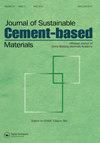Developing a comprehensive prediction model for the compressive strength of slag-based alkali-activated concrete
IF 4.2
3区 工程技术
Q1 CONSTRUCTION & BUILDING TECHNOLOGY
Journal of Sustainable Cement-Based Materials
Pub Date : 2023-10-14
DOI:10.1080/21650373.2023.2266442
引用次数: 0
Abstract
AbstractThis study aims to evaluate the effects of mix design parameters of ambient-cured slag-based alkali-activated concrete (GAAC) and develop a prediction model for its compressive strength (CS) by emphasizing the chemical compositions of alkaline solutions. A test setup including 625 specimens, in 125 mixes, was designed. A comprehensive parametric study and statistical evaluation were performed. Findings revealed the effectiveness of Na2O, SiO2, H2O, and GGBFS contents compared to the dosage of alkaline solutions and highlighted their disadvantages. The results also discovered the efficiency of the Bayesian linear regression in the simulation compared to the artificial neural network. Two models for estimating the CS of GAAC with reasonable accuracy were also proposed. Carbon footprint evaluation revealed that the carbon dioxide reduction of substituting ordinary concrete with GAAC depended on the desired properties of the concrete and was equal to 33% for grade 35 MPa concrete.Keywords: Alkali-activated concreteprediction modelcompressive strengthparametric studystatistical evaluationMachine learning Disclosure statementNo potential conflict of interest was reported by the author(s).Data availability statementSome or all data, models, or codes that support the findings of this study are available from the corresponding author upon reasonable request.Notes1 The difference in H2O and water in the mixtures is due to the water-sodium hydroxide flakes reaction in SH. (2NaOH+H2O→Na2O+2H2O).建立了矿渣基碱活化混凝土抗压强度综合预测模型
摘要本研究旨在评价环境固化渣基碱活化混凝土(GAAC)配合比设计参数的影响,并以碱性溶液的化学成分为重点,建立其抗压强度(CS)预测模型。设计了包括625个试样、125种混合料的试验装置。进行了综合参数研究和统计评价。结果表明,Na2O、SiO2、H2O和GGBFS的添加量与碱性溶液的添加量相比是有效的,并突出了它们的缺点。与人工神经网络相比,贝叶斯线性回归在仿真中的效率更高。提出了两种具有合理精度的GAAC CS估计模型。碳足迹评价表明,用GAAC替代普通混凝土的二氧化碳减量取决于混凝土的期望性能,对于35mpa等级的混凝土,二氧化碳减量为33%。关键词:碱活化混凝土预测模型抗压强度参数研究统计评估机器学习披露声明作者未报告潜在利益冲突数据可用性声明支持本研究结果的部分或全部数据、模型或代码可根据通讯作者的合理要求获得。注1混合物中H2O和水的差异是由于水-氢氧化钠薄片在SH (2NaOH+H2O→Na2O+2H2O)中反应所致。
本文章由计算机程序翻译,如有差异,请以英文原文为准。
求助全文
约1分钟内获得全文
求助全文
来源期刊
CiteScore
6.60
自引率
15.90%
发文量
71
期刊介绍:
The Journal of Sustainable Cement-Based Materials aims to publish theoretical and applied researches on materials, products and structures that incorporate cement. The journal is a forum for discussion of research on manufacture, hydration and performance of cement-based materials; novel experimental techniques; the latest analytical and modelling methods; the examination and the diagnosis of real cement and concrete structures; and the potential for improved cement-based materials. The journal welcomes original research papers, major reviews, rapid communications and selected conference papers. The Journal of Sustainable Cement-Based Materials covers a wide range of topics within its subject category, including but are not limited to: • raw materials and manufacture of cement • mixing, rheology and hydration • admixtures • structural characteristics and performance of cement-based materials • characterisation techniques and modeling • use of fibre in cement based-materials • degradation and repair of cement-based materials • novel testing techniques and applications • waste management

 求助内容:
求助内容: 应助结果提醒方式:
应助结果提醒方式:


